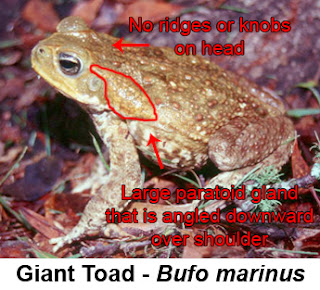 |
| Photo courtesy of the University of Florida Wildlife Extension |
Symptoms occur very quickly and include profuse salivation, brick red gums, pawing at the mouth, incoordination and difficulty breathing. If intervention does not occur, seizures and death may follow. As mentioned, puppies and small dogs are most at risk due to their size and the severity of the amount of toxin exposure. The more toxin per pound absorbed into the bloodstream, the poorer the prognosis. In the event your dog has come into contact with a Bufo, the first thing to do is rinse the dog’s mouth out copiously
for 5-10 minutes with a water bottle, garden hose or sink sprayer. Do not allow the dog to swallow the water and do not force water down the throat, this will only enable more toxin to be absorbed. Rinse the mouth side to side with the head facing downward if possible. A wash cloth saturated with water may be used to wipe out the mouth if the dog will not tolerate a hose or sink sprayer. Be sure to use caution as a panicked pet may inadvertently bite you while you are trying to rinse the mouth. After rinsing the mouth copiously, make your way to your veterinarian or to an emergency clinic if your regular veterinary office is closed.
There is no anti-toxin to reverse these effects but supportive care provided by your veterinarian is crucial. If seizures have occurred, your veterinarian will be able to give anti-convulsants to stop the seizures and monitor the vital signs such as your dog’s heart rate. Uncontrolled seizure activity can cause an elevated temperature and the toxin can cause an irregular heartbeat. Intravenous fluid therapy can be used to decrease fever along with cool water baths. If the heart is beating irregularly, anti-arrhythmic cardiac drugs are available to correct this issue. Early intervention and follow up with a veterinarian is critical to saving the life of your beloved pet.
To prevent exposure to a Bufo toad, pet parents should first be aware of what this toad looks like; from younger toads to the adult stage. These are not frogs, which tend to be colorful and have webbed feet. Bufos can grow to be quite large, up to 9 inches in length with bumpy brown skin. In rainy weather, they are more likely to be found in the grass in your yard. Be sure to check swimming pools, ponds and other areas where these toads will be likely to congregate. Try to keep dogs on a leash at all times, controlling their exposure to plants, hedges and shrubbery. Bufo toads eat a variety of foods, including pet food. Minimize exposure by not leaving pet food in areas where toads could have access to it. Raise food bowls if pets are fed outside and clean bowls immediately after feeding time. If your yard is fenced, you can place chicken wire around the bottom of the fence making it more difficult for toads to gain entry to your yard.
Recognizing the Bufo, securing your dog’s environment and knowing what to do in case of intoxication can make all the difference. Prepare an emergency plan ahead of time by knowing your vets hours of operation and where the local emergency clinic is. Carry a water bottle with you on walks, pay attention to the dog’s environment and avoid times of the day the Bufo is most active. Most of all, remember to rinse out your dogs mouth if exposed, this step is perhaps the most important and can make the difference between a minimal exposure and a life-threatening tragedy.
Written by Dr. Laura Allison
Read more or contact Dr. Allison:
Laura Allison, DVM
Lap of Love Veterinary Hospice
(954) 778-8908
Pompano Beach, FL
drallison@lapoflove.com | www.lapoflove.com
Dr. Allison services Broward County, including Pompano Beach, Lighthouse Point, Hillsboro Beach, Deerfield Beach, Coconut Creek, Oakland Park, Wilton Manors, Coral Springs, Tamarac, Plantation, Sunrise, Lauderhill, Oakland Park, Ft. Lauderdale, Aventura, Miramar, Hollywood, Davie, Pembroke Pines, Cooper City, and Weston.


No comments:
Post a Comment
Note: Only a member of this blog may post a comment.